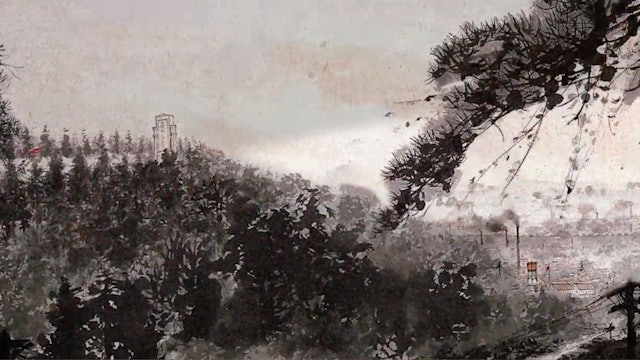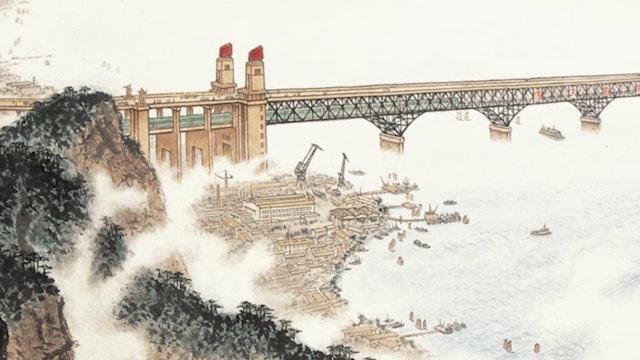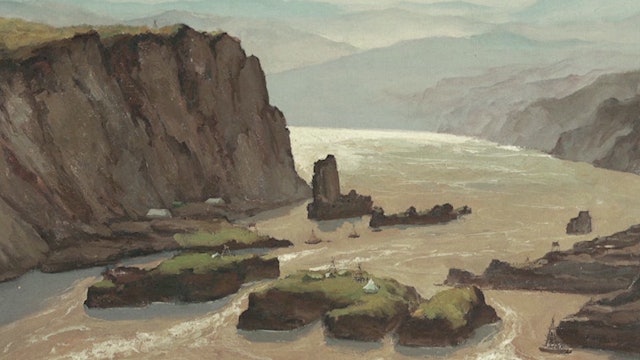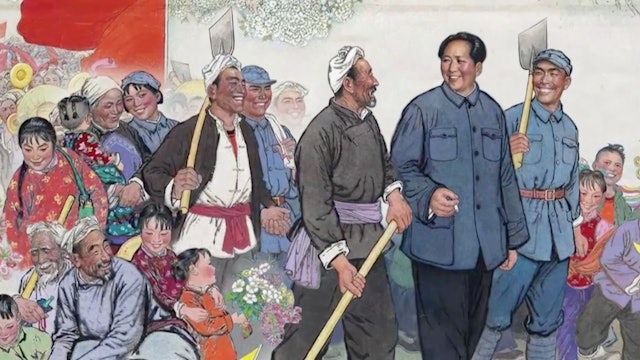Walk through CPC's history
"The Art of the Party" series shows you the historic moments of the Communist Party of China and its founding.
-
Chengdu-Chongqing Railway
This oil painting, titled “Roadbuilding Pioneers,” was created by Chinese artists Chen Yifei and Wei Jingshan in 1972. It depicts Chinese people united to build the Chengdu-Chongqing railway in a tough environment in the early 1950s. It's the first railway line constructed after the People’s Repu...
-
The Dawn on the Honghu Lake
This painting depicts the Honghu armed forces under the leadership of the Communist Party of China, launching a successful attack against counter-revolutionary forces in the 1920s.
-
Gutian Conference
In December 1929, Chinese Red Army delegates gathered in the town of Gutian in eastern Fujian Province to discuss how to build a new party and army, which became an important milestone in the history of the CPC.
-
The Bloodstained Shirt
This sketch, entitled “The Bloodstained Shirt,” was created by Chinese realist painter Wang Shikuo in 1959. It depicts farmers rising up to fight for their land rights in a town in East China's Shandong province.
-
PLA troops capture the city of Nanjing
This painting “Occupying Presidential Palace” depicts the moment when the Chinese People’s Liberation Army captured the KMT “presidential palace” on April 23, 1949.
-
Yuhuatai Memorial
The painting “Yuhuatai Memorial” commemorates the Chinese Communists who perished during the revolution.
-
Farmers and Tractors
China’s agricultural production was significantly damaged due to a long period of war in the 1940s. This painting, “Farmers and Tractors” was created by Li Qi in 1950, inspired by China's agricultural mechanization.
-
Ode to the Red Candle
Chinese artist Wen Lipeng created this oil painting “Ode to the Red Candle” in memory of his father Wen Yiduo, a prominent Chinese poet and scholar. Wen Yiduo was also a fearless warrior in China’s democratic revolutionary movements in the 20th century.
-
Eight Heroines
“Eight Heroines” depicts the eight heroines of the Chinese soldiers helped protect the Chinese forces by distracting the Japanese at China’s War of Resistance Against Japanese Aggression.
-
Locomotive Doctor
In 1952, Chinese railway workers made great efforts to manufacture the first steam locomotive, also named ‘August 1st’. The painting “Locomotive Doctor” shows the optimism and fighting spirit of the railway workers.
-
The Premier and The People
Chinese artist Zhou Sicong created a painting, titled "The People and The Premier" based on the rebuilding of Xingtai City in Hebei Province in northern China after powerful earthquakes in 1966.
-
Nanjing Yangtze River Bridge
This Chinese painting was created by Chinese artist Wei Zixi in the 1970s. It was modeled on the Nanjing Yangtze River Bridge, the first modern bridge designed and built by China.
-
Thousands of Hills in a Crimsoned View
This ink wash painting was created by Chinese artist Li Keran, inspired by “Changsha” - one of the best-known poems by the late Chairman Mao Zedong. The poem expresses an “optimistic vision of the future of the revolution and the motherland.”
-
Preparation for the founding of the PRC
On September 21, 1949, 662 representatives from all walks of life gathered in Beijing to attend the first Chinese People’s Political Consultative Conference in preparation for the founding of New China.
-
Wind of the South - Special Economic Zones
In 1980, China decided to establish special economic zones in Shenzhen, Zhuhai, Shantou in South China's Guangdong Province and Xiamen in Southeast China's Fujian Province, which boosted China’s economic reform and opening up.
-
Battle of Luding Bridge
The Battle of Luding Bridge was a major Red Army victory during the Long March. Find out more from this painting.
-
Daqing Oilfield Workers
In 1959, an #oilfield was discovered in northern #China and was named “Daqing” which means “big celebration.” It has produced over 50 million tonnes of crude annually for 27 consecutive years. Today, Daqing remains China’s largest oilfield.
-
Flood prevention in Wuhan
In 1954, the Yangtze River Basin suffered a number of catastrophic floods due to an unusually high volume of precipitation. Under the leadership of the CPC, people across the country were united to help Wuhan residents fight against the floods.
-
The Battle of Loushan Pass
The painting, “The Battle of Loushan Pass” depicts the fierce battle in Loushan Pass in 1935 between the Chinese Red Army led by the CPC and the Brigade of the Guizhou Army controlled by the Kuomintang (KMT).
-
Centennial Monument
In 1919, thousands of Chinese students went to France to participate in a new program called the Diligent Work-Frugal Study Movement. Find out more from this bronze sculpture.
-
March of a million troops
In the spring of 1949, during peace talks with the CPC, the KMT deployed a heavy battalion of troops along the Yangtze River to prevent the People's Liberation Army from crossing the river.
-
Sanmenxia Dam on Yellow River
The Sanmenxia Dam was the first large water conservation project on the Yellow River after the new China was founded in 1949. It controls rapid changes in water levels and helps to preserve the region's ecosystems.
-
The Happy Canal in Yan’an
The painting, “The Happy Canal in Yan’an” talks about a canal called “Happy Canal, ” which was built by Chinese soldiers led by the CPC and villagers in Shaanxi Province. Since then, villagers have seen crops harvest year after year.


























